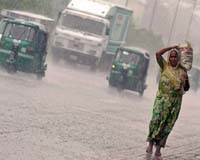| . |  |
. |
New Delhi (AFP) Dec 1, 2009 Groundwater at the site of the world's worst industrial accident in India's Bhopal city is still toxic and making residents sick 25 years after a gas leak there killed thousands, studies said Tuesday. An analysis conducted by the UK-based Bhopal Medical Appeal (BMA) also cast doubt upon government-sponsored research into the impact of the disaster at the Union Carbide pesticide plant, where methyl isocyanate gas spewed from a storage tank on December 3, 1984. Activists say more than 350 tonnes of toxic waste strewn around the site still pollutes soil and groundwater in the area, leading to cancer, congenital defects, immunity problems and other illnesses. Internal documents showed the company had been dumping thousands of tonnes of waste around the plant for years before the accident, and while the state government does not deny the material exists, it says it is harmless. "This report will nail their lie," Satinath Sarangi of the Bhopal Group for Information and Action told AFP. "There are still high concentrations of carcinogens and birth defect-causing chemicals and heavy metals in the water," he said. According to research conducted by the state-run Indian Council of Medical Research (ICMR) until 1994, between 8,000 and 10,000 people were killed within the first three days of the tragedy, and 25,000 people later died from the effects of exposure. Government statistics compiled after 1994 concluded that at least 100,000 people living near the factory in Madhya Pradesh state were chronically sick, with more than 30,000 residing in areas with contaminated water. The BMA report said the infrastructure for clean drinking water set up by the city was inadequate, meaning many residents used groundwater out of desperation. The charity sent samples of hand-pumped groundwater from 15 Bhopal communities to laboratories in Switzerland and Britain, which showed concentrations of some toxins were actually rising "as the chemicals leach through the soil and into the aquifer", it said. The document criticised tests conducted by an Indian laboratory saying results showed very low chemical concentrations "despite the fact that some of the samples clearly smelled of solvents". It was "possible that the laboratory did not wish to pass on the correct results thanks to the ongoing political controversy around the Bhopal disaster," the reports' authors said. Union Carbide -- purchased by Dow Chemical in 1999 -- insists all liabilities toward the plant were cleared in a 1989 out of court settlement worth 470 million dollars, the bulk of which was used to compensate victims. A 2004 high court order for the state government to clean up the waste has resulted in only a partial clearance of toxins. "You can't wish them away. They need to be cleaned up," said Sarangi. A separate study released Tuesday by the Centre for Science and Environment (CSE) showed a hand-pump three kilometres (two miles) from the plant contained 110 times the maximum concentration of the pesticide carbaryl deemed safe in Indian bottled water. "The factory site in Bhopal is leading to chronic toxicity -- continuous tiny exposure leading to poisoning," said Sunita Narain, director of the CSE. Share This Article With Planet Earth
Related Links Our Polluted World and Cleaning It Up
 Gas tragedy leaves legacy of 'Bhopal brides' 25 years on
Gas tragedy leaves legacy of 'Bhopal brides' 25 years onBhopal, India (AFP) Nov 30, 2009 Jyoti is one of many Indian women whose dreams of a glittering wedding were shattered after the Bhopal gas disaster killed thousands 25 years ago this week and left many more ill from exposure. Having endured the lethal billow of methyl isocyanate gas which seeped from the Union Carbide plant on December 3, 1984, Jyoti and her contemporaries then suffered the stigma of being survivors. ... read more |
|
| The content herein, unless otherwise known to be public domain, are Copyright 1995-2009 - SpaceDaily. AFP and UPI Wire Stories are copyright Agence France-Presse and United Press International. ESA Portal Reports are copyright European Space Agency. All NASA sourced material is public domain. Additional copyrights may apply in whole or part to other bona fide parties. Advertising does not imply endorsement,agreement or approval of any opinions, statements or information provided by SpaceDaily on any Web page published or hosted by SpaceDaily. Privacy Statement |